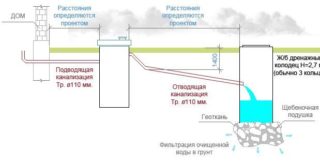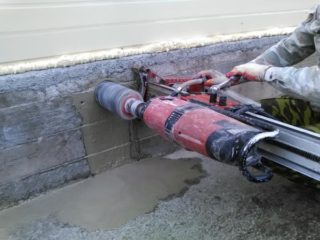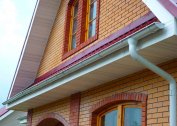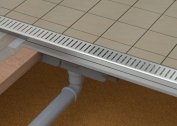Calculation and installation of the sewer line in the building under construction is carried out in the process of laying its foundation. But it is possible to enter the sewage system under the foundation and into the already built house. In this case, it will be necessary to create a passage under the base or to punch a hole in it using a percussion instrument.
Preparatory work
The project of the sewer system of a private house must be completed even before the installation work begins. It requires the following points to be taken into account:
- the ability to connect to a central sewer network or install a local cleaning device;
- use of the building for permanent or temporary residence;
- number of residents and potential guests;
- the proximity of plumbing and kitchen.
If it is not planned to connect to the citywide sewage system, it is necessary to select the type of treatment plant: cesspool, septic tank, bio-treatment station.
If the house is being built from scratch, a project for drainage systems is created along with the plan of the building itself. This allows you to arrange all the water intake points in the most compact way, which contributes to the creation of a simple and effective sewage system with a single drain pipe. Typically, plastic lines with a cross section of 100 mm are selected. In this case, even before the start of construction, you can calculate which way to choose for laying sewers under the base plate. In the case of creating a highway in an already erected building, it is somewhat more difficult to do, but it is also possible.
Depth of location of communications
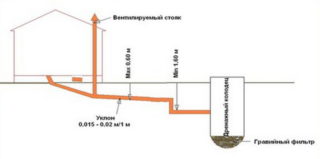 The laying of the external sewage line is carried out at a depth below the level of freezing of the soil. With this embodiment, it will not fail even with very severe frosts. If this is not possible, the pipeline will have to be insulated.
The laying of the external sewage line is carried out at a depth below the level of freezing of the soil. With this embodiment, it will not fail even with very severe frosts. If this is not possible, the pipeline will have to be insulated.
Pipes are laid in advance dug a ditch on a sand cushion and heat-insulating building materials. The slope must be performed based on a calculation of at least 2 cm per meter of communication.
Construction and sanitary standards recommend taking into account the level of underground sources. The smallest pipeline laying depth is 0.5 m from the soil surface.
The laying of the trunk inside the house depends on the place, height and type of sanitary devices. The main requirement is compliance with the slope for quick independent passage of sewage. Plumbing fixtures must be placed above the connection to the main riser. Its lower end is displayed in the basement or basement, where the horizontal part of the trunk is mounted and connected to the pipe exiting through the hole in the foundation part.
On a long highway, every 5 m, inspection wells are arranged. To do this, a tee is installed and a vertical pipe length is displayed up. To prevent cold from entering through the audit, it is closed with a plug from the heat insulator.
Ways to lay sewage
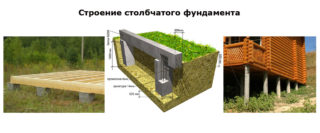 The selection of methods depends on the type of foundation of the structure. With the right approach, it is possible to equip the pipeline already in the constructed building.
The selection of methods depends on the type of foundation of the structure. With the right approach, it is possible to equip the pipeline already in the constructed building.
Column and pile foundation
Doing work in buildings with similar foundations is easiest. Columnar and pile foundations allow installation of communications before the construction of the main elements and after the construction of the house. During the work, it is monitored that the trench is not dug too close to the pillars to avoid weakening of the soil around them. This can reduce their bearing qualities.
To remove the pipeline from the foundation space into the sanitary room, you will need to make a hole in the slab under the sewer line.
When holding pipes under a columnar base, it must be remembered that the space under the floor is not heated. The mains are insulated with insulating materials or additional heating is installed using an electric cable.
Monolithic plate
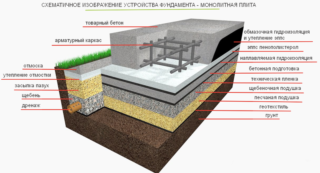 The laying of the sewage system is possible only before filling the monolithic base. Here you will definitely need sleeves for sewer pipes. They do not allow the slab base to create a load on the pipe, and also prevent damage to the communications in the foundation slab when pouring concrete mortar. If an emergency occurs, you can quickly dismantle the damaged area and replace it with a new pipe section.
The laying of the sewage system is possible only before filling the monolithic base. Here you will definitely need sleeves for sewer pipes. They do not allow the slab base to create a load on the pipe, and also prevent damage to the communications in the foundation slab when pouring concrete mortar. If an emergency occurs, you can quickly dismantle the damaged area and replace it with a new pipe section.
The sewer line, protected by sleeves, is laid in a previously dug trench, which is then filled with soil and poured with concrete mixture.
Tape base
If it is possible to lay the system before pouring concrete tape, use two methods, depending on the type of foundation.
| Depth of foundation | |
| Small | Big |
| Pipes are placed in a ditch, the bottom of which is below the freezing point of the earth directly under the base. The area under the tape itself is protected by a pre-worn piece of metal pipe. | A hole is cut out in the formwork, into which an asbestos-cement or steel sleeve is installed. It is fixed and poured with concrete. A tube section is subsequently inserted into the resulting hole. |
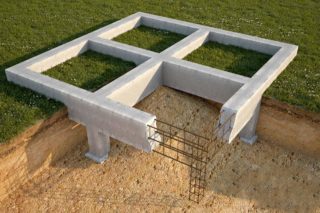 The strip foundation allows laying the line after filling the foundation. Carrying out work of this kind requires great effort and cost, but all of them are quite accessible for independent execution, without hiring specialists. The process can be carried out in two ways: under the base they make a digging and through it pipes are removed or a hole is drilled in a concrete tape.
The strip foundation allows laying the line after filling the foundation. Carrying out work of this kind requires great effort and cost, but all of them are quite accessible for independent execution, without hiring specialists. The process can be carried out in two ways: under the base they make a digging and through it pipes are removed or a hole is drilled in a concrete tape.
Arrangement of sewage in a rebuilt house
To install a sewage system in a rebuilt building with a base-tape, in addition to pipes, a hammer and a scarp, a perforator, an electric drill, UGShM with diamond disks, a jumper will be required.
Underground construction
The first method involves the creation of a kind of well in the place where it is supposed to conduct sewage out.
- Open the floors from the drain point to the removal of the pipeline to the outside. To connect the main and internal systems, a hole is made in the floor slab.
- A trench is dug up to the lower foundation edge.
- Under the base they beat a hole in the ground with a crowbar and make a dig under the foundation.
- A pit is paved from the house. For work, you can use a sapper or bayonet-shovel.
- Increase the digging in accordance with the cross section of the future highway and install a metal sleeve with a smooth tap. It will be located under the foundation with a 20-30 cm outlet, the direction of the pipe is up into the house.
- After installing the protective case, the pit is filled up and tamped. If it is heavy, you will need a sand bed to prevent damage to the pipe.
To facilitate the work, you can use the inclined drilling method. The input of the drill is carried out at an angle. This method is used with a significant thickness of the tape base.
Foundation drilling
To punch a hole in the concrete foundation under the sewer with your own hands, you need to master the puncher. This method is easier than the previous one, but you will need skills in the tool.
- They clean and level the workplace. The drill bit should enter smoothly and smoothly.
- On the basis, make a mark where the pipe will be installed. The hole should be of such a diameter that allows you to insert a sleeve that protects the pipe section.
- A punch in concrete punch holes of the required size.It is possible to drill a foundation strip under the sewer and an impact electric drill with a drill for concrete.
- Across rebar rods are removed by drilling.
- A metal section is installed in the prepared hole and the space around it is filled with cement mortar.
- A pipeline is led out through a metal pipe, and the gap between them is closed with foam. She also acts as a heat insulator.
In this embodiment, a special purchase part with rubber seals can be used as a sleeve. After its installation, sewer communications are passed through a prepared channel, the unit is fixed with seals.
